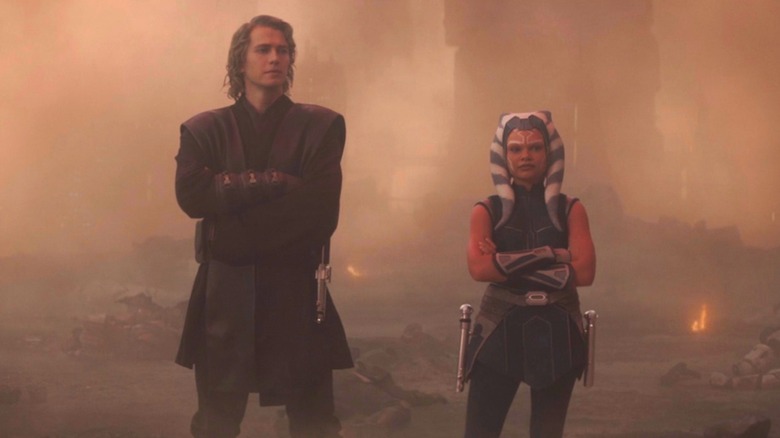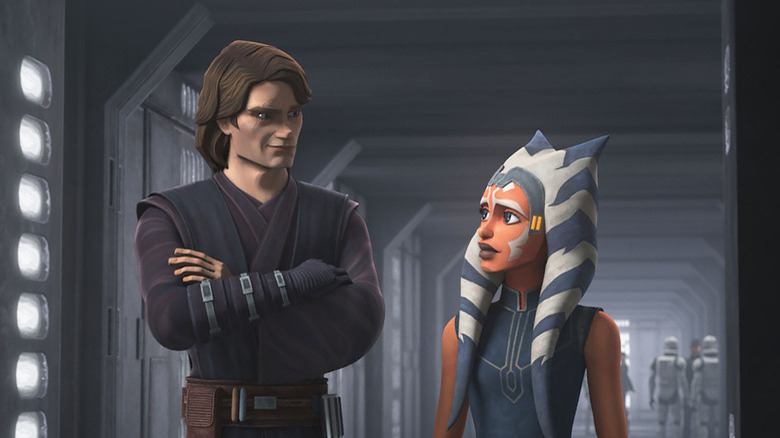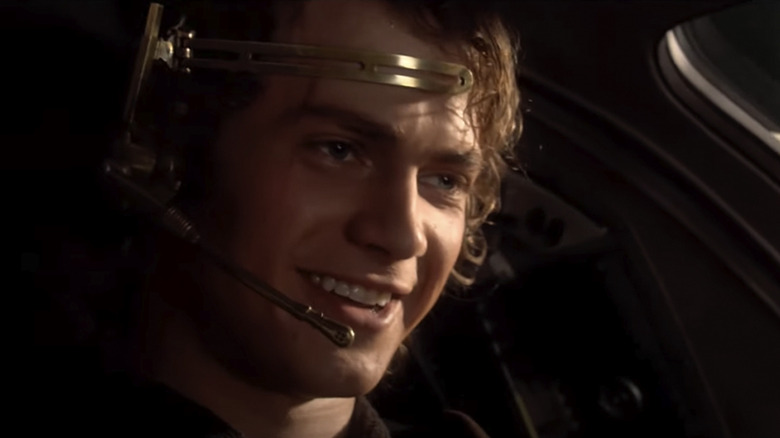How Ahsoka Bridges A Major Gap In Anakin Skywalker's Story
When Hayden Christensen revealed he binged-watched the "Star Wars" animated shows to prepare for his return to the franchise far, far away in "Obi-Wan Kenobi," fans were incredibly excited, but there was one problem. Incorporating elements of the animated performance in live-action, without acknowledging the things that make animation different than live-action, it risked being little more than an imitation for the sake of fan service.
This is a problem that is plaguing "Ahsoka." The show has incorporated a lot of callbacks to "The Clone Wars" and "Rebels," from bringing those shows' characters to live-action, to spotlighting goofier things like a war criminal robot and a lightsaber battle in zero-G. The problem is that these lose something in translation. When directly recreating iconography from the animated shows, the impact is lost because they are inherently different mediums.
When the latest "Ahsoka" episode brought us back to the cartoons, literally, via a flashback to the early episodes and the last arc of "The Clone Wars," it risked becoming too fan-service-focused. But thanks to the writing and Christensen's performance, which features less brooding than the movies and was more aligned with his attitude in "The Clone Wars," this episode actually helped to fill an important gap in the story of Anakin Skywalker.
This is where the fun begins
Hayden Christensen's prequel performance has been heavily criticized and mocked for decades, mostly because of the way the character is written, with George Lucas imagining a particularly annoying and unlikable character — at first. By the time of "Revenge of the Sith," it is hard to care about the character for his own sake, and not just because other people say they care about him. Anakin was supposed to be the key to the entire six-film saga, but he ended up being the least interesting part of them.
That all changed with "The Clone Wars," a show that gave audiences a vastly different portrayal of the Chosen One than they had seen. Animated Anakin was a more adventurous, charming, funny Jedi knight who you could definitely imagine was admired by all his peers, feared by his enemies, and respected by his friends. The show made his fall to the dark side clearer and less of a left turn, and it made it sad and tragic because we came to know and love the character. He was a hero, a mentor, a husband, and a brother.
Having Christensen suddenly embody that version of the character in live-action, without any of that extra context, would be rather jarring — a clear nod to a part of the franchise not everyone was familiar with. Thankfully, the effect is the complete opposite, because the episode frames Anakin's appearance from the point of view of Ahsoka and how she saw her master at two pivotal moments in her life. Here, we see a summarized version of the arc Anakin went through in the years between the films.
You underestimate my power!
When we left Anakin in "Attack of the Clones," he was a moaning, annoying, and very hormonal teenager — basically an edgelord. But then at the start of "Revenge of the Sith," Anakin is cracking jokes and expressing joy at the notion of insurmountable odds and near-certain death. He is still the reckless man who jumped out of a speeder to chase a bounty hunter in peak traffic, but now it feels less dumb and more swashbucklingly heroic in a way. Sadly, the movies give us no context whatsoever for this change. But the cartoons do.
As we see in this episode, Anakin became a wise-cracking, larger-than-life hero during the war, a time when his recklessness, his disregard for the rules, and his physical prowess were not reprimanded, but commended. The Anakin we see in the first flashback when Ahsoka was a kid is wise and funny, a big brother who cares deeply about his friends. This has as much to do with Anakin being a bloodthirsty madman who thrives in war as it does with the fact that having a padawan forced him to be more considerate to others.
In the second flashback, however, which takes place right as Anakin makes his fall to the dark side, Anakin becomes colder and angrier, ripe to become a child killer once Ahsoka leaves him. Audiences who watched "The Clone Wars" know this, and saw his transformation play out slowly and meticulously over several years, but the movies skip this part. Seeing "Ahsoka" deliver the version of Anakin Skywalker that movie audiences never got to see, and having it fill in an important gap in a way that doesn't replace the cartoons, is one of the best things about this show so far.


